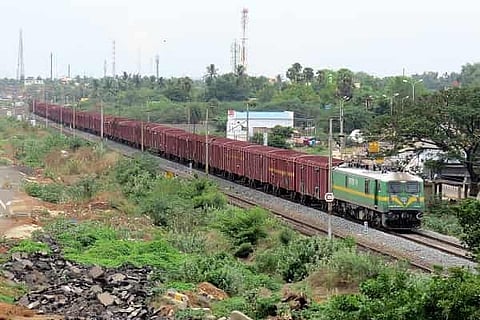
- News Updates
- PSU Watch
- Defence News
- Policy Watch
- हिन्दी न्यूज़
- Jobs Watch
- States News
- Event News

Mumbai: A dedicated freight corridor has given a boost to the modal (freight movement) shift from road to rail even as a host of factors, including the absence of a sector regulator, impeding this shift, a report said on Friday.
According to credit ratings agency CareEdge, container cargo transported through railways grew by 17.63 percent year-on-year to 74.38 million metric tonnes during the previous fiscal as compared to 12.51 percent growth in overall container cargo volumes.
"The rail coefficient also expanded by 115 bps to 26.70 percent during FY22, mainly supported by partial connectivity of the dedicated freight corridor (DFC) with Mundra and Pipavav ports on the western coast," it added. This marks the beginning of the modal shift from roads to rail, the ratings agency added.
It noted that the slated completion of the DFC project by June 2023, increased trips of cost-effective double-stack container trains and incremental volumes of cement cargo through railways are major factors influencing the switch from roads to rail.
CareEdge said that transit assurance under DFC with a reduction in transit period by 40-50 percent for some of the routes will accelerate this transition.
"Based on estimates, inventory carrying cost constitutes 43 percent of the overall cost of logistics. Thus, a significant reduction in transit duration is expected to help in achieving just-in-time based inventory management thereby boosting the cost competitiveness of domestic goods," CareEdge said.
CareEdge also said that transit assurance under DFC aims to squeeze the travel period by 40-50 percent for some of the major routes and over 3x growth in the movement of cost-effective double stacker container trains by FY25 will accelerate this transition.
"However, higher haulage rates for freight traffic due to extensive cross-subsidization of passenger traffic and the absence of a regulatory body for the railways are the underlying key challenges for the modal shift," the report said.
"Nevertheless, prevailing high haulage rates for operating container trains due to extensive cross-subsidization with passenger freight, challenges in establishing end-to-end connectivity and the absence of regulator in Railways unlike other key infrastructure segments are impeding the modal shift of cargo from roads to rail," said Rajashree Murkute, Senior Director for Corporate Ratings at CareEdge Ratings.
(PSU Watch– India's Business News centre that places the spotlight on PSUs, Bureaucracy, Defence and Public Policy is now on Google News. Click here to follow. Also, join PSU Watch Channel in your Telegram. You may also follow us on Twitter here and stay updated.)
